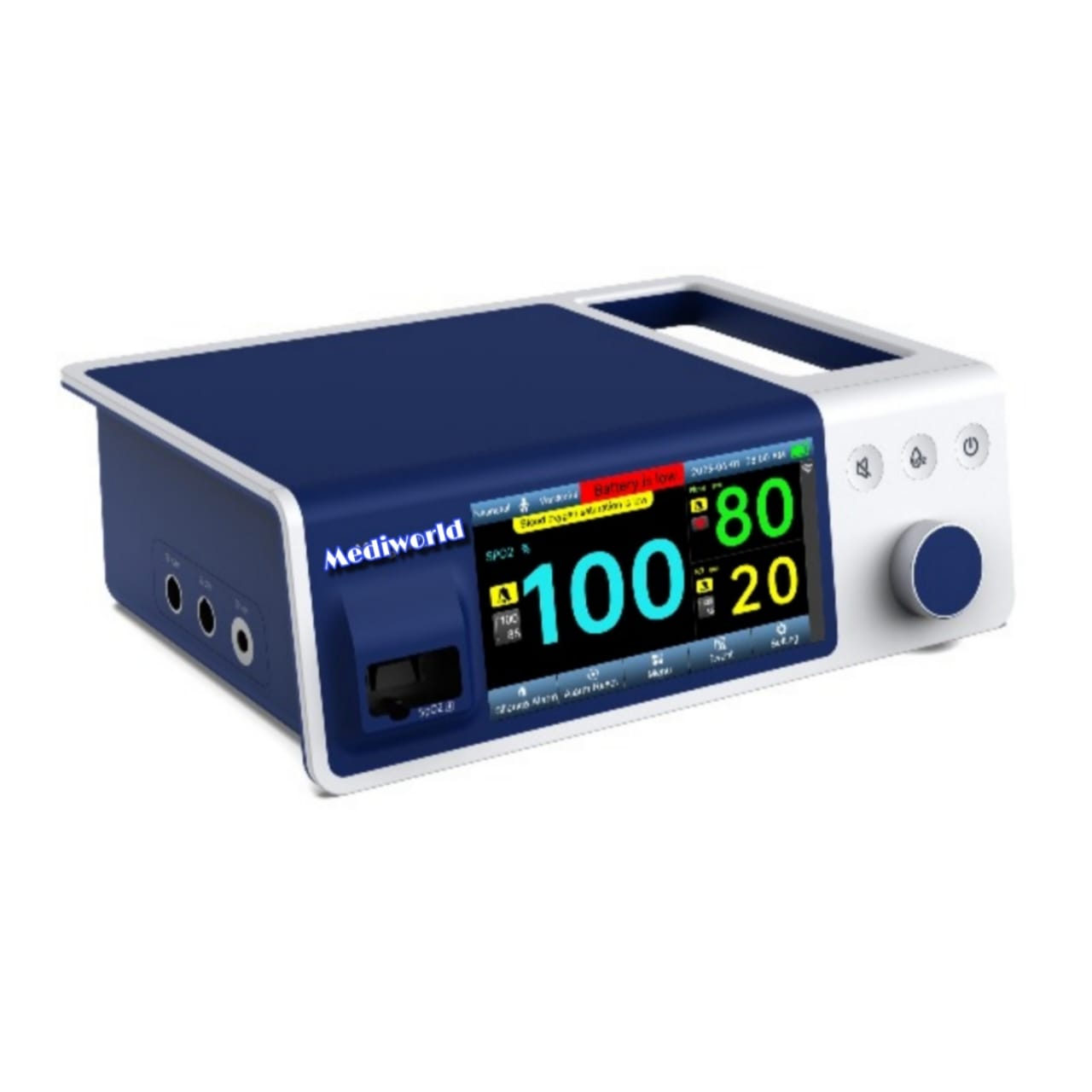
Pulse Oximeter Tabletop
Set Defaults Efficiently: Allows biomedical engineers and technicians to set institutional defaults simply and effectively. Easy Maintenance: Enables easy battery replacement, diagnostic execution to troubleshoot performance issues, and general maintenance within the hospital. Compliance with Standards: The new system meets medical electrical equipment standards and RoHs standards.
Features and Specifications:
| Measurement Range | |
|---|---|
| SpO2 | 1% to 100% |
| Pulse rate | 30 to 300 beats per minute (bpm) |
| Pulse amplitude | 0.025% to 20% |
| Respiratory rate | 4 bpm times per minute (ppm) |
| Temp | 5°C to 50°C / 41°F to 122°F |
| CO2 | 0 mmHg to 150 mmHg |
| DBP | 20-240 mmHg (Adult) / 20-200 mmHg (Pediatric) / 24-115 mmHg (Neonate) |
| SBP | 40-280 mmHg (Adult) / 40-240 mmHg (Pediatric) / 140-140 mmHg (Neonate) |
| NBP | 25-255 mmHg (Adult) / 25-215 mmHg (Pediatric, Neonate) |
| Accuracy | |
| SpO2 saturation (%) | 70% to 100% ± 2 digits (Adult/Neonate, no motion) 70% to 100% ± 3 digits (Adult/Neonate, motion) Low perfusion/PLB 0.025% 70% to 100% ± 2 digits |
| Pulse Rate (bpm) | 30 to 300 bpm ± 2 bpm (no motion, low perfusion) 30 to 300 bpm ± 4 bpm (motion, low perfusion) |
| NIBP (mmHg) | Maximum average error: ≤6 mmHg Maximum standard deviation: 8 mmHg |
| TEMP (°C / °F) | ±0.1°C or ±0.2°F |
| CO2 Mainstream (mmHg) | 0 mmHg to 40 mmHg ± 2 mmHg 0 mmHg to 114 mmHg ±5% 71 mmHg to 100 mmHg ±8% 101 mmHg to 150 mmHg ±10% |
| Electrical | |
| Power supply requirements | 100 to 240 VAC, 50/60 Hz |
| Fuse rating | Fast-acting 24.32 VAC/DC, Fast-acting 500 mA 32 VAC/DC |
| Battery type | Li-Ion; Voltage and capacity: 3.7V/5200 mAh |
| Battery capacity | Minimum of 6 hours using new, fully charged battery with no alarms |
| Environmental | |
| Operating Conditions | Temperature: 5°C to 40°C (41°F to 104°F) Altitude: -170 m to 4877 m (-557 ft to 16,000 ft) Pressure: 58 kPa to 103 kPa (17.1 in Hg to 30.4 in Hg) |
| Transport and Storage | Temperature: -20°C to 60°C (-4°F to 140°F) Altitude: -304 m to 6080 m (-1000 ft to 20,000 ft) Pressure: 58 kPa to 106 kPa (14.7 in Hg to 31.3 in Hg) Relative humidity: 15% to 95% non-condensing |
| Physical Characteristics | |
| Weight | 1.23 kg (2.71 lbs) |
| Size | 91 H x 265 W x 168 D (mm) / (3.58 H x 10.43 W x 6.62 D (in)) |
| Equipment Compliance | |
| Standards Compliance | EN ISO 80601-2-61: 2017 / EN IEC 60601: 2020 |
| Equipment Classifications | Type of protection against electric shock: Class 1 (internally powered) Degree of protection against electric shock: Type BF - Applied part Mode of operation: Continuous Electromagnetic compatibility: IEC 60601-1: 2020 Degree of safety: Not suitable for use in the presence of flammable anesthetics |
| Display Indicators | |
| Switch LCD color display | Different parameters are different colors |
| Visual indicators | Pulse search, audible alarms muted or off, interference indicator, battery charging, and alarm management clock, pitch |
| Alarms | |
| Audible and visual alarms | High/low SpO2/PR/NIBP/TEMP/CO2 |
| Audible and visual warning indicators | Low battery and sensor off |
| Audible and visual sensor disconnect alarms | Sensor disconnect alarms |
| System Characteristics | |
| NIBP measurement method | Automatic oscillometric method |
| NIBP operating mode | Manual, Automatic, Continuous |
| NIBP interval mode | [2, 3, 4] / 5, 7, 9, 10, 15, 28 min (HV1, 5h/2h/3h/4h/8h) |
| NIBP typical measurement time | 20–45s, Overpressure protection |
| CO2 initialization Time | Caprogram displayed in less than 20 seconds (teaching full specifications within 20 minutes) |
| Ordering Information | |
| Description | Bedside SpO2 Patient Monitoring System Bedside SpO2 Patient Monitoring System (NIBP-TEMP) Bedside SpO2 Patient Monitoring System (NIBP-TEMP-CO2) |